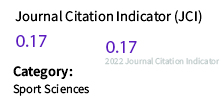Diferencias en las estadísticas de competición de tenis en los juegos olímpicos de Río de Janeiro 2016
DOI:
https://doi.org/10.24310/riccafd.2019.v8i3.7486Palabras clave:
análisis del rendimiento, deportes de raqueta, tenis profesional, servicio, restoResumen
El objetivo de este estudio fue conocer las estadísticas de competición de tenis en los JJOO de Río de Janeiro 2016. Para ello, se analizaron 282 sets de los 128 partidos en los que participaron un total de 128 tenistas (64 jugadores y 64 jugadoras). Los datos fueron seleccionados de la información publicada en la Web Oficial de la Federación Internacional de Tenis (http://www.itftennis.com/olimpiadas/cuadros). Los resultados mostraron que el género masculino obtuvo valores estadísticamente superiores en variables relacionadas con el servicio, mientras género femenino obtuvo mejores valores en variables relacionadas con el resto. Con respecto a la lateralidad, no se encontraron diferencias significativas entre zurdos y diestros en el género masculino. En el género femenino, las jugadoras zurdas obtuvieron unos valores significativamente superiores en el porcentaje de puntos ganados con el primer y segundo saque, número de puntos de break y número de puntos ganados al resto. La información obtenida en este trabajo establece unos parámetros de rendimiento que pueden resultar de utilidad para establecer objetivos y evaluar el rendimiento de los jugadores de tenis.Descargas
Métricas
Citas
Elmenshawy AR, Machin DR, Tanaka H. A rise in peak performance age in female athletes. Age (Omaha). 2015;37(3).
Torres-Luque G, Fernández-García ÁI, Blanca-Torres JC, Kondric M, Cabello-Manrique D. Statistical Differences in Set Analysis in Badminton at the RIO 2016 Olympic Games. Front Psychol [Internet]. 2019;10:731. Available from: https://www.frontiersin.org/article/10.3389/fpsyg.2019.00731
Malagoli Lanzoni I, Di Michele R, Merni F. A notational analysis of shot characteristics in top-level table tennis players. Eur J Sport Sci. 2014;14(4):309–17.
Garganta J. Trends of tactical performance analysis in team sports: bridging the gap between research, training and competition. Rev Port Ciências do Desporto. 2016;9(1):81–9.
Hughes MD, Bartlett RM. The use of performance indicators in performance analysis. Vol. 20, Journal of Sports Sciences. 2002. p. 739–54.
Courel-Ibáñez J. Análisis de la competición en pádel. In: Courel-Ibañez J, Cañas J, Sánchez-Alcaraz BJ, Alarcón R, editors. Investigación en pádel. Diego Marí. Murcia; 2014. p. 15–24.
Rein R, Memmert D. Big data and tactical analysis in elite soccer: future challenges and opportunities for sports science. Vol. 5, SpringerPlus. 2016.
Cross R, Pollard G. Datos sobre partidos de individual masculinos en Grand Slam 1991-2009. La velocidad del servicio y otros datos relacionados. Coach Sport Sci Rev. 2009;16(49):8–10.
Cross R, Pollard G. El tenis en los Grand Slams individuales de varones entre 1995 y 2009. Parte 2: Puntos, Juegos y Sets. Coach Sport Sci Rev. 2011;19(53):3–6.
Filip?i? T, Filip?i? A, Berendijaš T. Comparison of game characteristics of male and female tennis players at Roland Garros 2005. Acta Univ Palacki Olomuc Gymnica. 2008;38(3).
Kati? R, Milat S, Zagorac N, DJurovi? N. Impact of game elements on tennis match outcome in Wimbledon and Roland Garros 2009. Coll Antropol. 2011;35(2):341–6.
O’donoghue PG. The most important points in grand slam singles tennis. Res Q Exerc Sport. 2001;72(2):125–31.
Sánchez-Pay A, Palao JM, Torres-Luque G, Sanz-Rivas D. Differences in set statistics between wheelchair and conventional tennis on different types of surfaces and by gender. Int J Perform Anal Sport. 2015;15(3):1177–88.
Brown E, O’Donoghue P. Gender and surface effect on elite tennis strategy. Coach Sport Sci Rev Sport Sci Rev [Internet]. 2008;46:9–11. Available from: http://search.ebscohost.com/login.aspx?direct=true&db=s3h&AN=36007654&lang=es&site=ehost-live&scope=site
Carboch J. Comparison of game characteristics of male and female tennis players at grand-slam tournaments in 2016. Trends Sport Sci. 2017;24(4):151–5.
Hizan H, Whipp P, Reid M. Comparison of serve and serve return statistics of high performance male and female tennis players from different age-groups. Int J Perform Anal Sport. 2011;11(2):365–75.
Reid M, Morgan S, Whiteside D. Matchplay characteristics of Grand Slam tennis: implications for training and conditioning. J Sports Sci. 2016;34(19):1791–8.
Hughes M, Clark S. Surface effect on elite tennis strategy. In: Lees A, editor. Science and racket sports. London: E &FN Spon; 1995. p. 272–7.
O’Donoghue P, Ingram B. A notational analysis of elite tennis strategy. J Sports Sci. 2001;19(2):107–15.
Miller S. Modern tennis rackets, balls, and surfaces. Vol. 40, British Journal of Sports Medicine. 2006. p. 400–5.
Sánchez-Muñoz C, Sanz D, Zabala M. Anthropometric characteristics, body composition and somatotype of elite junior tennis players. Br J Sports Med. 2007;41(11):793–9.
O’Donoghue P, Ballantyne A. The impact of speed of service in Grand Slam singles tennis. In: Science and Racket Sports III: The Proceedings of the Eighth International Table Tennis Federation Sports Science Congress and the Third World Congress of Science and Racket Sports. 2004.
Sakurai S, Reid M, Elliott B. Ball spin in the tennis serve: Spin rate and axis of rotation. Sport Biomech. 2013;12(1):23–9.
Whiteside D, Reid M. Spatial characteristics of professional tennis serves with implications for serving aces: A machine learning approach. J Sports Sci. 2017;35(7):648–54.
Kovalchik SA, Reid M. Comparing matchplay characteristics and physical demands of junior and professional tennis athletes in the era of big data. J Sport Sci Med. 2017;16(4):489–97.
Reid M, McMurtrie D, Crespo M. The relationship between match statistics and top 100 ranking in professional men’s tennis. Int J Perform Anal Sport. 2010;10(2):131–8.
Courel-Ibáñez J, Sánchez-Alcaraz BJ. The role of hand dominance in padel: performance profiles of professional players. Motricidade. 2018;14(4):33–41.
Hagemann N. The advantage of being left-handed in interactive sports. Attention, Perception, Psychophys. 2009;71(7):1641–8.
Holtzen DW. Handedness and professional tennis. Int J Neurosci. 2000;105(1–4):101–19.
Loffing F, Hagemann N, Strauss B. The serve in professional men’s tennis: effects of players’ handedness. Int J Perform Anal Sport. 2009;9(2):255–74.
Menayo R, Fuentes JP, Moreno FJ, Clemente R, García T. The relationship between the speed of the ball and precision in the flat service in development tennis players [Internet]. Motricidad: European Journal of Human Movement. 2008. p. 17–30. Available from: http://dialnet.unirioja.es/servlet/articulo?codigo=3323285&info=resumen&idioma=ENG
Publicado
Cómo citar
Número
Sección
Licencia
Todos los contenidos publicados en Revista Iberoamericana de Ciencias de la Actividad Física y el Deporte están sujetos a la licencia Creative Commons Reconocimento-NoComercia-Compartirigual 4.0 cuyo texto completo puede consultar en <http://creativecommons.org/licenses/by-nc-sa/4.0>

Se pueden copiar, usar, difundir, transmitir y exponer públicamente, siempre que:
- Se cite la autoría y la fuente original de su publicación (revista, editorial y URL de la obra).
- No se usen para fines comerciales.
- Se mencione la existencia y especificaciones de esta licencia de uso.
Los derechos de autor son de dos clases: derechos morales y derechos patrimoniales. Los derechos morales son prerrogativas perpetuas, irrenunciables, intransferibles, inalienables, inembargables e imprescriptibles.
De acuerdo con la legislación de derechos de autor, Revista Iberoamericana de Ciencias de la Actividad Física y el Deporte reconoce y respeta el derecho moral de los autores/as, así como la titularidad del derecho patrimonial, el cual será cedido a la Universidad de Málaga para su difusión en acceso abierto.
Los derechos patrimoniales, se refieren a los beneficios que se obtienen por el uso o divulgación de las obras. Revista Iberoamericana de Ciencias de la Actividad Física y el Deporte se publica en open access y queda autorizada en exclusiva para realizar u autorizar por cualquier medio el uso, distribución, divulgación, reproducción, adaptación, traducción o transformación de la obra.
Es responsabilidad de los autores/as obtener los permisos necesarios de las imágenes que están sujetas a derechos de autor.






.png)








9.png)
